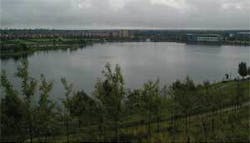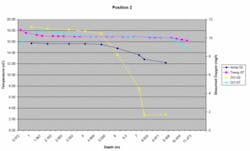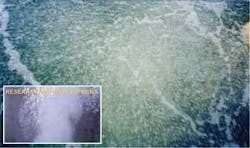Enhanced Mixing Aids in Reservoir Aeration
Innovative Aquaerator technology from AMG Ltd. reduces needs for additional drinking water treatment down the line.
Reservoirs and lakes are wonderful wildlife havens whilst often supporting a challenging recreational environment for water sports such as sailing, windsurfing, kayaking and fishing. A rapidly growing population is increasing pressure on water resources in the United Kingdom and meteorological patterns are changing, which many consider could be an effect of climate change. Therefore, experts in water resource management are increasingly employed to assist water companies in creating symbiosis between recreational users, water resources and water quality.
A level of complexity
It’s quite usual for reservoirs in the UK - or anywhere, really - to thermally stratify in deeper areas, which decreases the water quality at greater depths. In summer months, air temperature warms up the surface or Epilimnion layer and because the light from the sun cannot penetrate down to the bottom of the reservoir (due to water refraction and turbidity), it creates a warm oxygenated and less dense top layer, which naturally sits on top of the cooler dense Hypolimnion layer at the bottom.
In autumn, when air temperature decreases, this cools the surface layer to such an extent that the water temperature on the surface can be equal to the water temperature in the bottom dense layer, whereby the reservoir naturally “turns over” to create a well mixed homogenous reservoir roughly between October and May.
The naturally aerated Epilimnion layer is usually well mixed and contains a high amount of dissolved oxygen (DO) - 80-130%. This layer is often conducive to growth of algae, which can generate into toxic algal blooms, able to produce geosmin and 2-methylisoborneol (MIB). These toxins can create taste and odour problems even after treatment and such blooms can also prevent recreational activities and harm small animals.
The Metalimnion or thermocline - a transition layer between surface and deep water where temperature changes rapidly with depth - is usually described as when the water temperature decreases by at least 1°C per 1 m of water. The lower or Hypolimnion layer is much denser than the Epilimnion, contains little or no DO (0-25%) and is usually colder in the summer months.
It’s an increasing phenomenon that as a probable result of thermal stratification, significantly higher than normal concentrations of manganese, iron, aluminum and other heavy metals are released into the water column and concentrated in the Hypolimnion. It’s well known that many draw off towers - fitted with valves to take water from the reservoir to the treatment plant - may be positioned to siphon water from the bottom of the reservoir. This water may be low in DO, and high in concentrations of metals particularly manganese and iron. Low quality grade water presents a problem to the water companies as it greatly increases the costs of water treatment.
A common mistake made by some water companies is to upgrade the water treatment works to overcome water quality problems. This requires considerable capital investment, when in many cases all that’s needed is to upgrade or install a new aeration and mixing system in the raw water reservoir.
Advanced aeration
AMG Ltd. has over 35 years of experience working with aeration equipment and has evolved a new innovative reservoir mixing system. The Aquaerator Project has received a massive European Commission grant of just under ?1 million to undertake the research and development, which was sub-contracted to HR Wallingford and the University of Barcelona. The unit is a cutting edge mixing and aeration device which has evolved as a result of combining the best facets of both the air curtain and other aeration designs.
The Aquaerator sits on a shallow galvanised steel base on the reservoir bed to prevent damage to the ecology and mixing of bed sediments within the water column. Water is drawn through the device via a series of angled vanes that naturally injects swirl into the rising plume. Compressed air is fed through a series of air jets, which are designed to increase the swirl in the bubble plume. As mixed air and water are pushed through the unrestricted draught tube towards the surface, it entrains the reservoir’s middle and top water layers. For example, at 12 L/s at NTP (air at normal temperature and pressure), the mixed air/water bubble plume at the top of the draught tube (2 m) is 175 L/s. From a depth of 10 m this increases to 4.5 tonnes/sec and from 20 m depth the plume rate is 13.4 tonnes/sec of mixed air and water. This design requires fewer units, resulting in savings on capital and running costs.
The separate consultancy section of AMG Ltd. uses the YSI 6600 multi-parameter sampling Sonde, which measures pH, temperature, depth, DO, chlorophyll A, turbidity and conductivity. These are all useful when analysing the in situ water quality of deep freshwater systems and helps to formulate a reservoir Environmental Management Plan. Sediment and water quality laboratory analysis using an accredited laboratory is also used.
This AMG technology has been applied recently to the new development complex “Lakeside,” in Doncaster, UK. The 22-hectare, man-made lake was completed in the 1990s and after subsequent water quality sampling in 2002 and 2006, which confirmed onset of thermal stratification from May to October, a four-unit Aquaerator system was installed.
Sample results in May 2007 showed that the average DO concentration below 10 m water depth was 1.65 mg/L (~10% saturation) and average water temperature was 8.51°C - a decrease of 8.3°C from the surface water temperature. Thermal stratification started to occur at a depth of about 5.5 m.
Positive results
After the Aquaeration system was turned on at the end of May, sampling in June 2007 proved there was no visible thermocline and the average water temperature below 10 m was 14.8°C, which had only decreased by a negligible 2.6°C from the surface water temperature. The DO improved dramatically in the near-bed water and the readings showed that the average concentration was 7.8 mg/L (~80% saturation). This DO concentration is significantly higher than the critical aquatic DO concentration of 2 mg/L (where fish kills are likely) and also is significantly higher than the 5 mg/L DO level that was issued for the controversial Cardiff Bay Barrage Scheme. To check the performance of the system, telemetry links can also be used to monitor the in situ DO levels in the deeper waters.
It was also found that during stratification, concentrations of manganese and iron in deeper waters reached 0.35 mg/L and 0.14 mg/L respectively. With the Aquaeration system in operation, concentrations in the near-bed water decreased to 0.027 mg/L and 0.005 mg/L, which are both well below UK drinking water standards. This facet is important, proving that sufficient aeration at the sediment water interface can prevent release of metals, thus reducing the need for considerable additional costs during the treatment process.
It has been found on some reservoirs that recreational users are unable to take full advantage due to summer drawdown levels and likely collisions with large numbers of inefficient systems. Efficiency of the Aquaerator means that far fewer units are required, which significantly reduces the running costs. This coupled with strategic positioning in deeper waters ensures recreational users can freely use the entire reservoir. WWI
Author’s Note:
Louisa Inch is marketing manager at AMG Ltd., a Glastonbury, Somerset, UK, specialist in advanced aeration/mixing systems for reservoirs, lakes and ponds. The company now offers a dovetailed service - utilizing an Ecosystem Approach, which is an integrated management conservation tool designed by the IUCN - with another consultancy to minimise potential nutrient pollution from non-point sources, with agriculture the largest contributor within a catchment area, enabling water companies to lower running costs. Contact: +44 (0) 1458 834 734, [email protected] or www.aquariusmg.com



